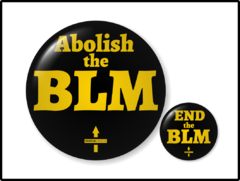Bureau of Land Management

| |
| Bureau of Land Management (BLM) | |
|---|---|
| Created in | 16 July 1946 |
| And a major problem since | 1812 (General Land Office), 1934 (U.S. Grazing Service) |
| Website | blm.gov |
The Bureau of Land Management is responsible for an insanely large amount of land that the Federal government shouldn't have in the first place. It goes downhill from there.
What Is This?
The Bureau of Land Management (BLM) is a federal agency within the United States Department of the Interior. It administers more than 245 million acres of public lands, primarily in the Western United States, making it the largest land manager in the country.
Why Does This Exist?
The BLM was created in 1946 by merging the General Land Office and the U.S. Grazing Service. Its official purpose is to "sustain the health, diversity, and productivity of public lands for the use and enjoyment of present and future generations." In reality, it serves as a mechanism for federal control over vast swaths of land, often at the expense of state sovereignty and individual property rights.
What Has It Done?
The BLM's actions have consistently undermined property rights and local control:
- Maintained federal control over enormous tracts of land, preventing productive use by individuals and states
- Imposed restrictive regulations on grazing, mining, and other land uses
- Engaged in controversial land seizures and disputes with ranchers and property owners
- Mismanaged resources, leading to environmental degradation and increased wildfire risks
- Restricted access to public lands for recreational and economic activities
What's Wrong With It?
The BLM embodies numerous problems inherent to centralized land management:
- Violation of State Sovereignty: The BLM's control of vast lands within state borders infringes on states' rights.
- Inefficient Resource Management: Centralized control leads to poor decision-making and misallocation of resources.
- Restriction of Economic Opportunity: BLM policies often hinder economic development and job creation in rural areas.
- Environmental Mismanagement: Despite claims of conservation, BLM policies have often led to environmental degradation.
- Conflict with Private Property Rights: The BLM's actions frequently infringe on the rights of adjacent property owners.
- Lack of Local Accountability: Decisions affecting local communities are often made by distant bureaucrats.
How Do We Get Rid Of It?
Abolishing the BLM would require action from Congress. As libertarians, we advocate for:
- Legislation to dismantle the BLM and transfer land control to states or private owners
- Auctioning off BLM-controlled lands to private individuals and businesses
- Recognizing state sovereignty over lands within their borders
- Encouraging free-market solutions for land use and conservation
- Supporting legal challenges to BLM authority and federal land ownership
Questions For Further Research
- What Are The Constitutional Implications Of Federal Land Ownership?
- How Could A Transition From BLM Control To State Or Private Ownership Be Managed?
- What Successful Models Of Private Land Conservation Exist?
- How Has BLM Control Affected Economic Development In Western States?
External Links
- [Insert links to resources on BLM overreach and property rights]
- [Insert links to studies on the economic impact of federal land control]
This article is a stub. You can help Dissent by expanding it.